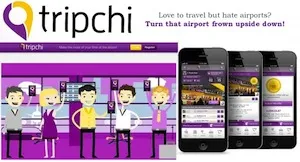Travel app tripchi, crowdfunds to make layovers at airports less tedious
Ever been stuck at airport due to a flight delay or a long stop-over and got bored out of your skull? Yes, its an all too common experience and let’s face it, most airports are highly uninteresting places. That’s what prompted the founders of travel app tripchi – “Love to travel, but hate airports. Us too, and we want to change that.” – to create a mobile app that helps travelers make the most of their time in the airport.
tripchi serves targeted recommendations of things to do in the airport based on your personality, interests and flight info. The app offers exclusive deals on food, drink, and shopping opportunities, the ability to connect with other travelers, as well as detailed content to explore the airport.

To get things started, tripchi has decided to go the crowdfunding route and are registered on Indiegogo to raise USD 10,000 by December 18. The money will be used to cover the build out of at least three airports that its crowd-investors vote for. Having raised USD 9,266 as on December 14, they are just USD 734 short of their target. We recently caught up with Chandra Jacobs, CEO of tripchi, to learn a little more about this interesting venture.
What is the monetization model for tripchi?
tripchi is free for travelers with revenue coming from our partners (airports, property management companies and vendors) via targeted ads, subscriptions for our targeted airport marketing platform, and white label solutions, as necessary. In-app purchases will come later, as well as a more robust analytics offering sold to airport stakeholders to improve the value of their content and marketing campaigns.
What is your market size and target segment?
There are over 400 million frequent travelers, spending $2.6 billion at airports annually and they could really do with reducing the agony of waits at the airport. In addition, there are over 50 million Gen-Y business travelers spending $341 million annually, and they would pay to better enjoy their time spent at the airport. Notice the difference – minimize agony versus increase enjoyment -- we will market to these two categories separately.
On the vendor side, concession sales alone at Boston Logan are $39 million, and the worldwide concessions market is worth $39 billion. If we raise the market spend from $14 to $20 of the travelers that already spend, we will raise concession sales by over $1 billion/year ($146 million in the Gen-Y demographic).
What led you to starting up? How did you conceive the company name?
Our team is composed of four people passionate about three things – traveling, using technology to make life easier, and applying analytics to personalize our products. Many of us have lived that George Clooney ‘Up in the air’ lifestyle, feeling like we spend more time in airports and on the road than we did actually in our own homes. We not only wanted to find ways to make traveling life less tedious, but also make it better!
We’ve been working together for about a year on this company, and my co-founder and I also have another company together, which demonstrates the commitment the team has for one another. We are also extremely fortunate to have the co-founder of SkyMall on our Board, as well as the CEO of a large software development company.
What are some of your short term targets?
Several milestones near-term:
- Close our Indiegogo campaign to raise $10-20K for additional product development costs.
- Release the Public Beta: Spring 2013 - PHX, BOS, SFO, NYC, CLT, DFW airports, scaling to two-four additional airports tech-friendly airports that also have higher delays and a high business traffic volume, as well as niche activity offerings that are unique and local in flavor.
- Make a sale by the end of spring. This means delivering either our white label app or airport loyalty solution, or bringing in affiliate revenue/subscription revenue from airport vendors/property management companies.
- Focus on establishing partnerships with 50% in Beta airports by the end of year one.
- Fall 2014: Raise $500-750K seed to allow tripchi to continue growth at about 10 more airports per year going forward.
Why did you decide to go for crowd-funding? How has the experience been? Any advice for others who may be looking at the crowd-funding route?
We came to a point in our product development where we needed to augment our internal development team with outside resources to speed up the pace that we were building at (most of our team is part-time). We can’t raise a seed round because we don’t have a public release yet, and we’ve already burned through our internal investment money. At the same time, we wanted to validate the concept with our customer base, generate interest, brand awareness, and create early product evangelists and adopters. Moreover, we wanted to learn from our customers and test out the mechanisms of our outbound marketing strategy. Indiegogo was therefore the perfect fit.
Our goal was to raise $10,000, which will cover the build out of at least three airports (that the Indiegogo community votes for). The more we raise, the more airports and special features, deals, and offers, we can include in the app for Indiegogo tripchi supporters.
We will also give supporters access before anyone else to the app once it's built, and engage with them every step of the way throughout our product development and testing process. We want our early supporters to be part of our team, and help us bring airports 2.0 to the world!
Indieogo vs. Kickstarter
They each have a different fit. Kickstarter is typically for ‘serious’ companies not necessarily the ‘fund my life’ campaigns that often clutter the Indiegogo pages. That said, Kickstarter also has a physical product focus (less so on software) and it is much harder to design perks that fit in. Perks take a really long time to think through and is a coordination headache between lining up vendors, negotiating prices, defining your margin, and ultimately setting the price you will offer the perk at. You want to have one-two perks under $50 (which is the average donation size).
The earlier you can reach out to people the better so you can prep them for what’s coming and ensure an initial “pop” of donations in the first weed. It’s extremely important to seed the campaign with donations from friends and family so that you can move fast up the ranking in the Indiegogo campaign pages through an elevated “Gogofactor.” This is an algorithm that Indiegogo uses to calculate which campaigns it will feature and your ranging in the Indiegogo pages.
A lot of factors go into it: Number of donations, amount of donations, where donations are coming from, velocity of donations, social media shares, how many comments you have on your campaign, how many team members are part of your campaign, how many items you have in your campaign gallery, and how many updates you send out. Advice – start early!
As of today, tripchi has raised USD 11,300 through their crowdfunding campaign. With less than a day to go, we wish them all the best! Check out their campaign here.







